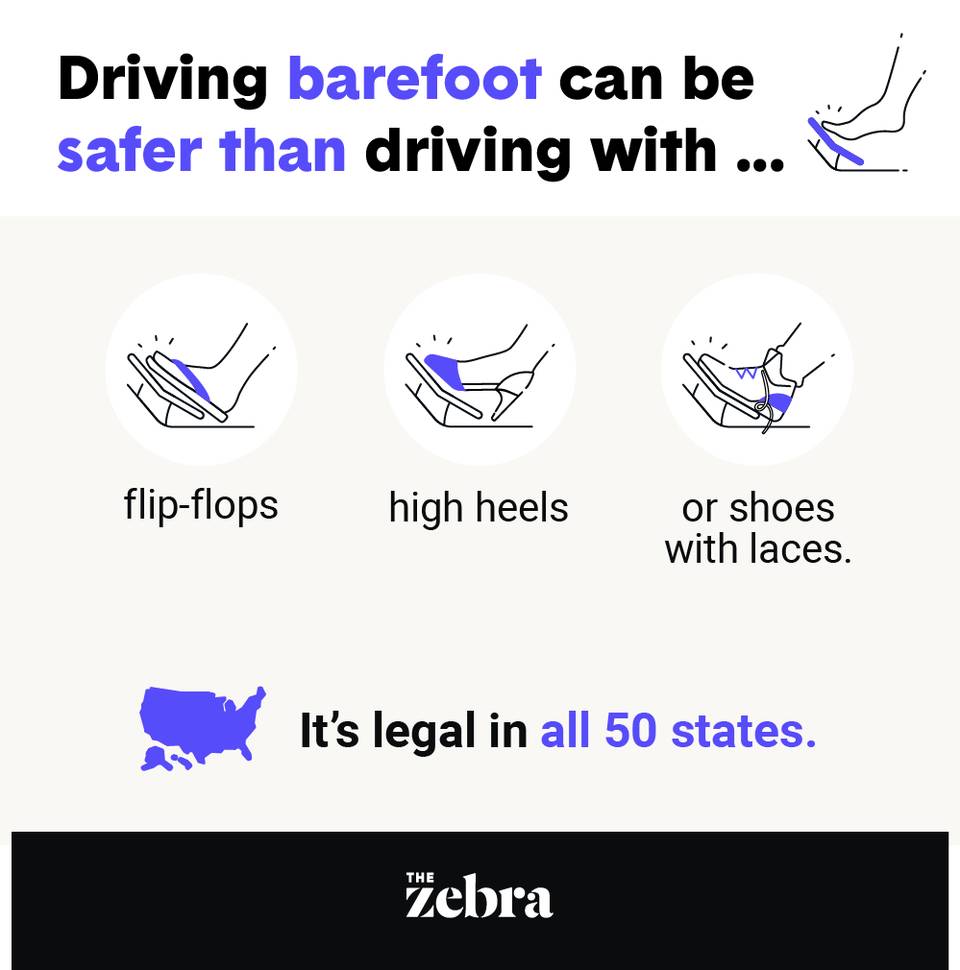Safety implications of driving barefoot
Part of what likely contributed to the barefoot driving urban legend is, of course, your grandparents’ worst fear: Your foot could slip off the pedal and cause a crash. However, this questionable fear doesn’t take into account the fact that virtually any kind of flimsy, loose, unsecured, or high-heeled footwear could pose the same dangers, as well as others. Here are some wider outlooks to consider on the issue:
- Bare feet may not have the same braking force as feet that are wearing a solid pair of shoes.
- Bare feet may slip off the pedals more easily. When people say something may happen “more easily,” the first thing to ask is “more easily than what?” Compared to shoes or boots that feature high-traction soles, bare feet are more slippery. However, the opposite is true when compared to slick-bottomed shoes like men’s or women’s dress shoes or high heels. The slip factor is also partly determined by the construction of the pedal coverings. Rubberized pedals are usually quite grippy, while plain metal ones can be slick.
- Driving barefoot can be safer than driving with flip-flops, high heels, or even shoes with long laces. Flip-flops get their name from their ability to flip up and flop around, and both of these attributes can pose serious problems when trying to drive. They can flip up under pedals, which is a massive hazard for stopping with the brake pedal or accelerating with the gas pedal. Also, they can flop to the side as you try to move your foot from the gas or brake pedals, blocking your foot from its destination. Again, the tangling is a huge problem if you need to put on the brakes, especially if you don’t have much time to stop.
- High heels pose similar difficulties; their elevation tends to interfere with the angle and foot movements needed for driving. Also, a tall heel can immobilize a pedal even more securely than a flip-flop can.
- Open-toed shoes also can pose the same hazard as flip-flops: getting hung up on or under the pedals and keeping your foot from properly pressing down. They also tend to have slick soles. And even secure, low-heeled, closed-toed shoes can pose a problem, if they have laces that are long enough to loop around a pedal and impede the movement of your feet.
- You can still be held responsible for negligence if you’re in an accident while driving barefoot. Barefoot driving could be seen as a cause of distracted driving. This is especially true if an officer believes your barefootedness has contributed to the wreck. Of course, such an assertion by an officer can be contested in court, and since it’s legal to drive this way, that aspect of any charges may well be thrown out. This would depend on the specifics of the case, as you might expect.
- However, it’s also important to remember that just because it’s legal to drive barefoot, that’s not a “get out of trouble free” card. Your other driving behaviors still count, not only in physics but also in the eyes of the law. Therefore, it’s important to always drive carefully, regardless of what you’re wearing on your feet.
- Local laws can still prohibit barefoot driving. Though no state authority bans driving without shoes, some cities, towns, or other municipalities may have their own regulations against it. If you want to be absolutely sure, you will therefore have to check the laws in each area where you intend to drive without shoes. While this is easy enough for your hometown or city, it could be quite a project for a cross-country drive.
Bearing all these facts in mind, it’s clear that there are no statewide prohibitions on driving barefoot. It’s also not mentioned by most municipalities — and in law, if something isn’t prohibited, it’s legal by default.
Despite the technical legality, you should put some thought into whether or not you should choose to drive barefoot. If your car has metal pedals, or the pedals are made of some other slick substance, it’s probably best to wear shoes with stable, grippy soles. On the other hand, driving with flip-flops on is extremely hazardous. It’s no joke when they get hung up under the pedals, forcing the brake pedal to stay up when you need to be stomping it down. The same is true for a variety of other footwear types; even wedge heels have been known to be problematic. If your choice is a pair of these shoes or none at all, go with none at all.
Another less-mentioned danger that comes with driving with bare feet is the effect of water. The sole of the human foot naturally has a surprising amount of grip — unless it’s wet. Then it becomes very easy for a foot to slip, even if a car has rubberized pedals. Therefore, if you’ve just walked barefoot through a rainstorm, gotten out of a pool or other water, or slopped through a puddle on your way to the car, you need to be sure to dry your feet before even turning on the car. Doing so might save you from some scary surprises and possibly even an accident.
With these caveats in mind, you should be able to drive barefoot as safely as you can with sensible shoes. You won’t have to worry about being cited for negligence, careless driving, reckless driving or anything similar, as long as you actually do drive safely. Nevertheless, we recommend driving with a sensible pair of close-toed shoes as that appears to be the safest practice.



